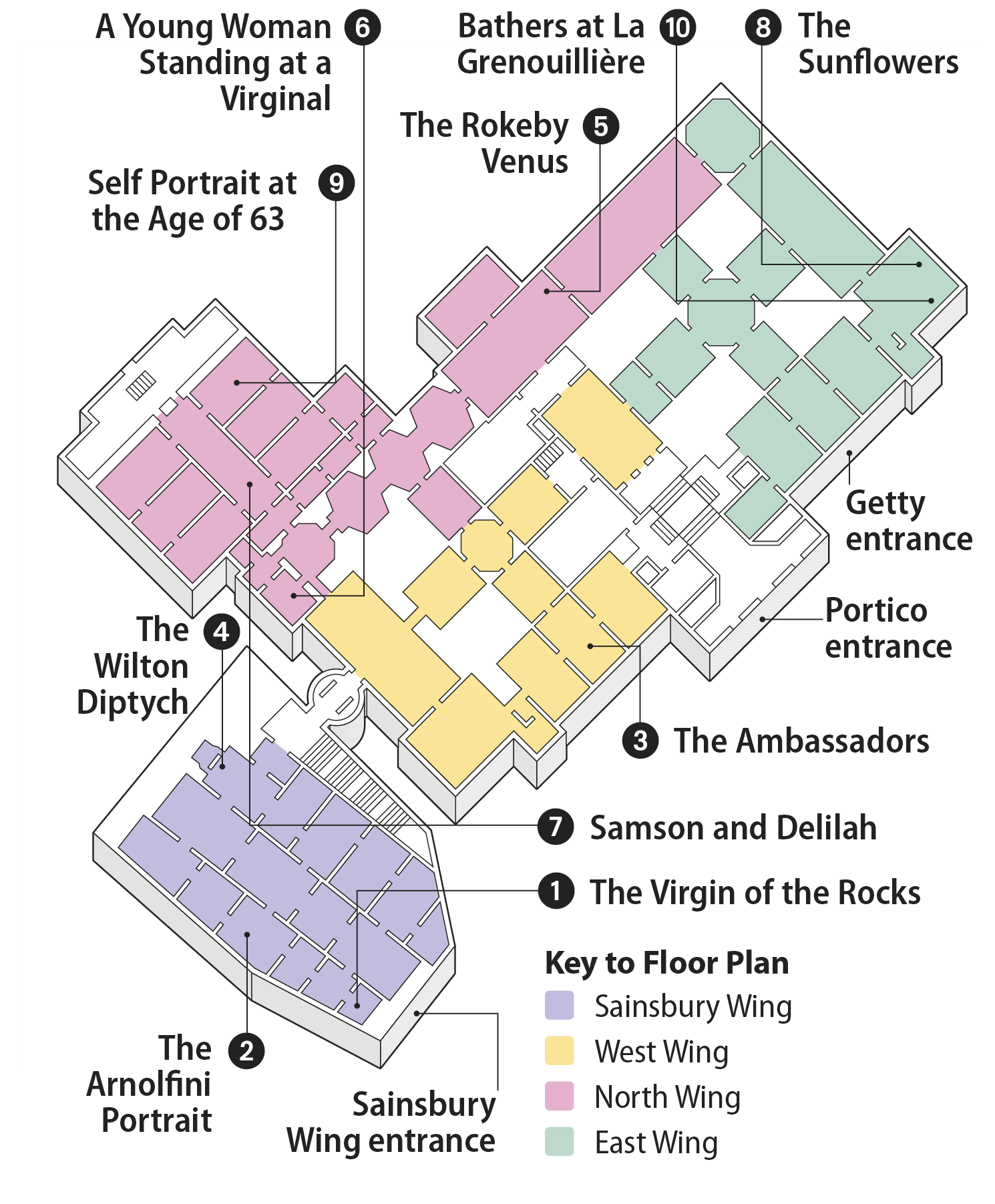
NATIONAL GALLERY
The National Gallery houses one of the world’s greatest collections of European paintings. The collection was established in 1824, when a small group of paintings was gifted to the nation, and after rapid expansion it was moved to the present building in Trafalgar Square in 1838. The gallery is now home to over 2,300 paintings dating from the 13th to the 19th centuries. The Sainsbury Wing, built in 1991, showcases the gallery’s outstanding collection of early Renaissance paintings and provides space for temporary blockbuster exhibitions.
NEED TO KNOW
![]() Trafalgar Square WC2 • 020 7747 2885 • www.nationalgallery.org.uk • Open 10am–6pm Sat–Fri (to 9pm Fri) • Adm free, except major temporary exhibitions •
Free guided tours at 11:30am and 2:30pm daily (lasts one hour)
Trafalgar Square WC2 • 020 7747 2885 • www.nationalgallery.org.uk • Open 10am–6pm Sat–Fri (to 9pm Fri) • Adm free, except major temporary exhibitions •
Free guided tours at 11:30am and 2:30pm daily (lasts one hour)
- There is a café, an espresso bar, and a good fine-dining restaurant.
- The Sainsbury Wing has an excellent art bookstore.
- Audio tours are available and trails can be downloaded from the museum’s website.
- Short lunchtime talks are held at 1pm Mon and Wed.
Gallery Guide
The gallery is divided into four areas. The Sainsbury Wing contains the Early Renaissance collection. The West Wing displays works from 1500–1600, the North Wing 1600–1700, and the East Wing 1700–early 1900s. Although the main entrance is on Trafalgar Square, the Sainsbury Wing makes a more sensible starting point.

Gallery Floor Plan
1. The Virgin of the Rocks
This Renaissance masterpiece by Leonardo da Vinci (1452–1519) was originally painted as an altarpiece for a church in Milan. The Virgin and Child, with St. John the Baptist and an angel, are depicted within a strange cavernous landscape.
2. The Arnolfini Portrait
One of the most famous paintings from the extensive Flemish collection is this unusual portrait of an Italian banker and his wife in Bruges. Jan van Eyck (c. 1385–1441) brought oil painting to a new and colorful height.
3. The Ambassadors
Symbols, such as the foreshortened skull foretelling death, abound in this 1533 painting by Hans Holbein (1497–1543).
4. The Wilton Diptych
A highlight of Gothic art, this exquisite English royal painting, by an unknown artist, shows Richard II being recommended to the Virgin by saints John the Baptist, Edward, and Edmund.

The Wilton Diptych
5. The Rokeby Venus
Painted in Rome to replace a lost Venetian painting, The Rokeby Venus is the only nude by Diego Velázquez (1599–1660), court painter to Spain’s Philip IV. Venus, the goddess of love, is depicted here with her son, Cupid, who holds a mirror up for her to see her reflection and that of the viewer.

The Rokeby Venus
6. A Young Woman Standing at a Virginal
Dutch painter Jan Vermeer’s (1632–75) works carry a sense of calm. Many of his interiors were painted in his home.
7. Samson and Delilah
This painting by Peter Paul Rubens (1577–1640) depicts the Old Testament legend and its theme of love and betrayal. Delilah caresses Samson while soldiers wait in the doorway to blind him.
8. The Sunflowers
Vincent Van Gogh (1853–90) painted this work in Arles, France, during a period of rare optimism while he was awaiting the arrival of his hero, the avant-garde painter Paul Gauguin.

The Sunflowers
9. Self Portrait at the Age of 63
Rembrandt’s (1606–69) self-portrait, created in the last year of his life, is among his most poignant works. He painted many self-portraits during his lifetime, and two of these are on display at the National Gallery.
10. Bathers at La Grenouillière
Claude Monet (1840– 1926), the original Impressionist, explored the effect of light on water at La Grenouillière, a popular bathing spot on the Seine close to Bougival to the west of Paris, where he worked alongside fellow painter Pierre-Auguste Renoir.
